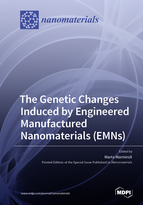The Genetic Changes Induced by Engineered Manufactured Nanomaterials (EMNs)
A special issue of Nanomaterials (ISSN 2079-4991). This special issue belongs to the section "Biology and Medicines".
Deadline for manuscript submissions: closed (30 September 2021) | Viewed by 13524
Special Issue Editor
Interests: bionanotechnologies; nanofertilizers; nanopesticides; nanotoxicology; transcriptomics; proteomics; metabolomics; plant-derived nanoparticles; macroalgae-derived nanoparticles
Special Issues, Collections and Topics in MDPI journals
Special Issue Information
Dear Colleagues,
The possibility that engineered manufactured nanomaterials (ENMs) can be harmful to the genetic materials of living individuals has been raised by several experiments, but it is, however, still controversial. In fact, there is also evidence that nanoparticles are not genotoxic and do not interfere with the genetic materials of organisms. It is of extreme importance to establish which nanomaterials have the potential to exert harmful effects on DNA in any type of living organisms, from simple prokaryotes to complex eukaryotes, starting from model organisms.
The aims and scopes of this Special Issue are to (1) highlight the research applications that find out which ENMs are genotoxic and which are the more susceptible organisms or cell lines, and (2) to pinpoint reliable methods to establish the genotoxicity of ENMs.
Dr. Marta Marmiroli
Guest Editor
Manuscript Submission Information
Manuscripts should be submitted online at www.mdpi.com by registering and logging in to this website. Once you are registered, click here to go to the submission form. Manuscripts can be submitted until the deadline. All submissions that pass pre-check are peer-reviewed. Accepted papers will be published continuously in the journal (as soon as accepted) and will be listed together on the special issue website. Research articles, review articles as well as short communications are invited. For planned papers, a title and short abstract (about 100 words) can be sent to the Editorial Office for announcement on this website.
Submitted manuscripts should not have been published previously, nor be under consideration for publication elsewhere (except conference proceedings papers). All manuscripts are thoroughly refereed through a single-blind peer-review process. A guide for authors and other relevant information for submission of manuscripts is available on the Instructions for Authors page. Nanomaterials is an international peer-reviewed open access semimonthly journal published by MDPI.
Please visit the Instructions for Authors page before submitting a manuscript. The Article Processing Charge (APC) for publication in this open access journal is 2900 CHF (Swiss Francs). Submitted papers should be well formatted and use good English. Authors may use MDPI's English editing service prior to publication or during author revisions.
Keywords
- Engineered manufactured nanomaterials (ENMs)
- Genotoxicity
- DNA fingerprinting
- Model organisms
- Genomic interaction
- Proteomics
- Metabolomics







